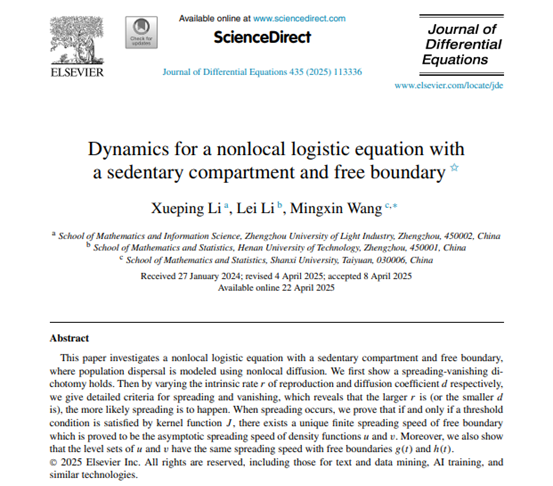| [栏目图片] |
Dr. Li Xueping from the School of Mathematics and Information Science Publishes a Research Paper in the Journal of Differential Equations |
|||
|
|
|||
|
|||
|
Recently, Dr. Li Xueping from the School of Mathematics and Information Science published a research paper titled Dynamics for a Nonlocal Logistic Equation with a Sedentary Compartment and Free Boundary in the internationally renowned Journal of Differential Equations (CAS Zone 1, TOP journal). Zhengzhou University of Light Industry is listed as the first authoraffiliation, with Dr. Li Xueping as the first author. The work was conducted in collaboration with Dr. Li Lei from Henan University of Technology and Professor Wang Mingxin from Shanxi University. This paper investigates a nonlocal logistic equation with resident population components and free boundaries, in which population dispersal is characterized by nonlocal diffusion. The study first establishes that the long-term dynamics of the model exhibit a propagation–vanishing dichotomy. By varying the intrinsic growth rate r and the diffusion coefficient d, the authors derive detailed criteria for propagation and vanishing, showing that larger values of r (or smaller values of d) increase the likelihood of propagation. In the case of propagation, a unique finite free boundary propagation speed exists if and only if the kernel function J satisfies a threshold condition. This speed is shown to coincide with the asymptotic spreading speed of the density functions u and v. Moreover, the study proves that the level sets of u and v propagate at the same speed as the free boundary. The findings reveal the influence of sedentary population components on species spreading dynamics and uncover an accelerated spreading phenomenon induced by nonlocal diffusion. These insights provide theoretical guidance for introducing advantageous species or inhibiting the invasion of alien species. This work further develops a previous study by Li Xueping and collaborators (Dynamics for the Diffusive Logistic Equation with a Sedentary Compartment and Free Boundary, Applied Mathematics Letters, CAS Zone II, 152 (2024), 109038). This research was funded and supported by the National Natural Science Foundation of China. Journal article link: https://www.sciencedirect.com/science/article/abs/pii/S0022039625003638?via%3Dihub |
|
Copyright © 2014 Zhengzhou University of Light Industry, China. All Rights Reserved. Add: No.136 Ke Xue Avenue,Zhengzhou,HenanProvince,PRC. Zip Code:450000 It is recommended that you use IE7 and above version of the browser to visit the web site. |
